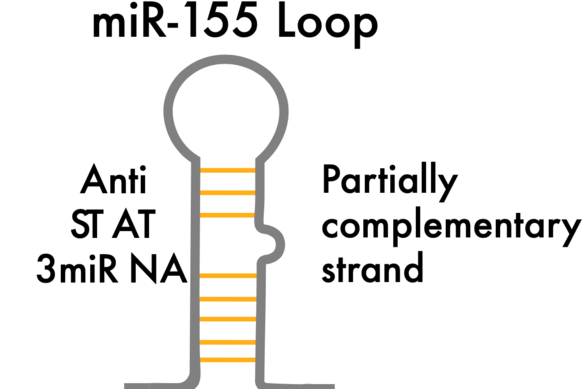Part:BBa_K3063987:Design
eSIBR casette with amiRNA insertion site
The part encodes three amiRNAs that silence signal transducer and activator of transcription 3 (STAT3), SRY (sex determining region Y)-box 4 (SOX4) and SRY (sex determining region Y)-box 9 (SOX9). STAT3-, SOX4- and SOX9-targeting amiRNAs in the transformed salmonella, will form dsRNAs upon binding to stemness STAT3, SOX4 and SOX9 mRNAs in tumour cells respectively. Under the aid of this particular biobrick, silencing of STAT3, SOX4 and SOX9 genes in liver cancer stem cells can be achieved simultaneously.
Sequence and Features
- 10COMPATIBLE WITH RFC[10]
- 12COMPATIBLE WITH RFC[12]
- 21INCOMPATIBLE WITH RFC[21]Illegal BglII site found at 585
Illegal BglII site found at 1409
Illegal XhoI site found at 1486 - 23COMPATIBLE WITH RFC[23]
- 25INCOMPATIBLE WITH RFC[25]Illegal NgoMIV site found at 1866
- 1000COMPATIBLE WITH RFC[1000]
Introduction
Biology
Part structure
The part for gene silencing of STAT3, SOX4 and SOX9 in cancer stem cells
BBa_K3063901, BBa_K3063902 and BBa_K3063903 The part encodes three amiRNAs that silence signal transducer and activator of transcription 3 (STAT3), SRY (sex determining region Y)-box 4 (SOX4) and SRY (sex determining region Y)-box 9 (SOX9). STAT3-, SOX4- and SOX9-targeting amiRNAs in the transformed salmonella, will form dsRNAs upon binding to stemness STAT3, SOX4 and SOX9 mRNAs in tumour cells respectively. Under the aid of this particular biobrick, silencing of STAT3, SOX4 and SOX9 genes in liver cancer stem cells can be achieved simultaneously.
Part Therapeutics
Recent findings have demonstrated that STAT3-mediated signaling is implicated in regulating the undifferentiated phenotype of stem cells and suppressing antitumor immunity, while in vitro silencing is capable of inducing G2/M arrest in a variety of cancer cell types. [1] [2] [3] Hence, we postulated that STAT3-targeting amiRNA, carried by salmonella, can effectively silence STAT3 expression in liver stem cells, which in turns minimises the cancer stemness.
Aside from the therapeutic potential of STAT3, evidence has been accumulating that SOX4, whose expression initiated by STAT3, orchestrates epithelIal-to-mesenchymal transition (EMT) through upregulating a series of EMT-inducing transcription factors, which then enhances cellular growth as well as transformation. [4] SOX4 knockdown can effectively reduce the activation of transforming growth factor-beta (TGF-β) signaling, attenuating the invasion of cancer cells. [5]
For Sox9, it has long been known to overexpress in tumor, in particular, cancer stem cells, which maintains self-renewal capacity of CSCs through constitutive activation of Notch signalling pathway [6] Metastatic cells show further elevation of Sox9 than non-metastatic ones, indicating the role of the gene in cancer progression, possibly via Wnt/β-catenin signaling. [7]
References
- ↑ Galoczova, M., Coates, P., & Vojtesek, B. (2018). STAT3, stem cells, cancer stem cells and p63. Cellular & molecular biology letters, 23(1), 12.
- ↑ Raz, R., Lee, C. K., Cannizzaro, L. A., d’Eustachio, P., & Levy, D. E. (1999). Essential role of STAT3 for embryonic stem cell pluripotency. Proceedings of the National Academy of Sciences, 96(6), 2846-2851.
- ↑ Li, J., Liu, Y. Y., Yang, X. F., Shen, D. F., Sun, H. Z., Huang, K. Q., & Zheng, H. C. (2018). Effects and mechanism of STAT3 silencing on the growth and apoptosis of colorectal cancer cells. Oncology letters, 16(5), 5575-5582.
- ↑ Lourenço, A. R., & Coffer, P. J. (2017). SOX4: joining the master regulators of epithelial-to-mesenchymal transition?. Trends in cancer, 3(8), 571-582.
- ↑ Foronda, M., Martínez, P., Schoeftner, S., Gómez-López, G., Schneider, R., Flores, J. M., ... & Blasco, M. A. (2014). Sox4 links tumor suppression to accelerated aging in mice by modulating stem cell activation. Cell reports, 8(2), 487-500.
- ↑ Liu, C., Liu, L., Chen, X., Cheng, J., Zhang, H., Shen, J., ... & Qian, C. (2016). Sox9 regulates self‐renewal and tumorigenicity by promoting symmetrical cell division of cancer stem cells in hepatocellular carcinoma. Hepatology, 64(1), 117-129.
- ↑ Aguilar-Medina, M., Avendaño-Félix, M., Lizárraga-Verdugo, E., Bermúdez, M., Romero-Quintana, J. G., Ramos-Payan, R., ... & López-Camarillo, C. (2019). SOX9 Stem-Cell Factor: Clinical and Functional Relevance in Cancer. Journal of oncology, 2019.





